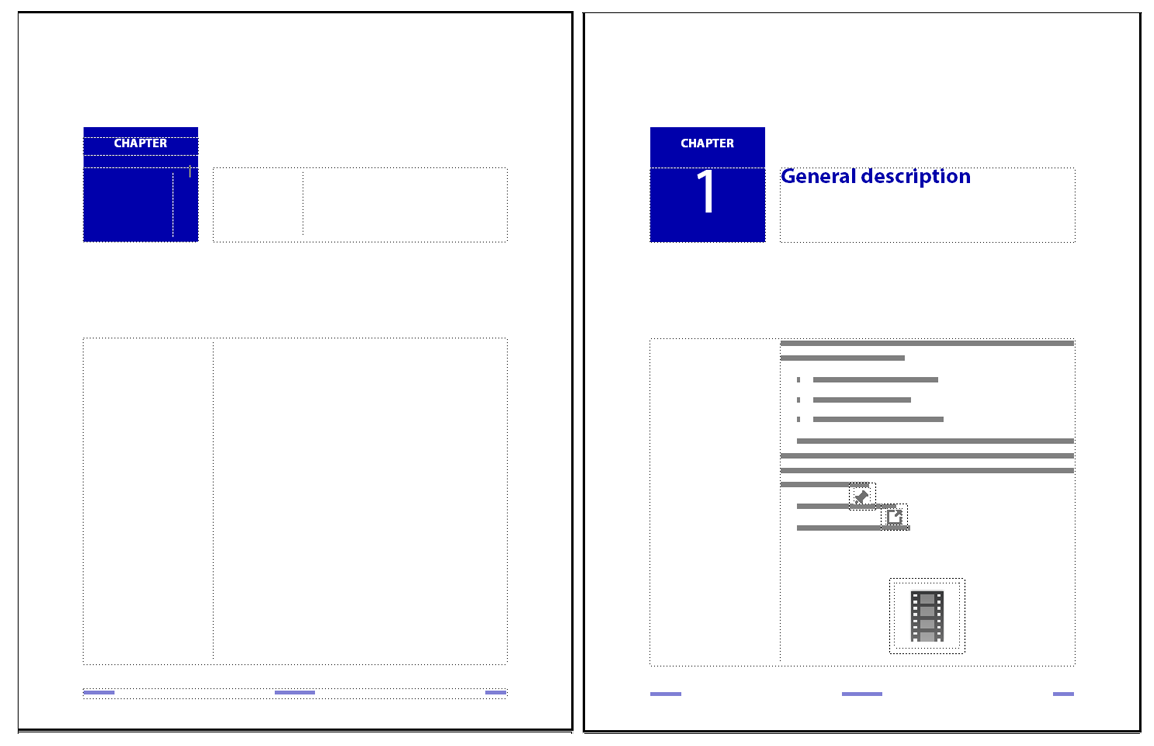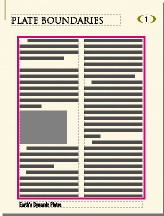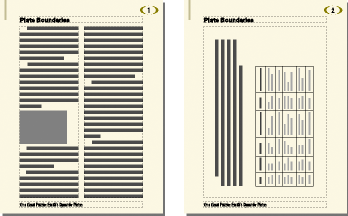Know the master pages in Adobe FrameMaker and their usage.
Understand template text frames and background text frame.
FrameMaker uses master pages to keep track of a
document’s page layout. A double-sided document contains at least
two master pages, one for left pages and one for right pages. A
single-sided document uses the right master page only. Documents
can also contain custom master pages, which you can use for special
types of pages. You can also create layouts directly on body
pages for one-time-only use.
If your page layout is complex, or if you need to create design
components such as page headers and footers, work with the components
directly on the master pages. You can draw or import graphics—such as
lines, boxes, or company logos—anywhere on a master page, as well
as type text on them. Graphics and text appear on the corresponding
body pages exactly as they appear on the master page, as part of the
body page’s background.
Figure 1. Master page and body page
Master pages can contain the following types of text frames:
A template text frame contains a tagged text flow—a
flow with a name. When you add a body page, the template text frame
is copied to the new body page. You then type the document’s text in
this text frame on the body page. You can type text in a template
text frame on a master page, but the text does not appear on body
pages.
A background text frame contains an untagged text
flow—a flow with no name. Its contents appear on corresponding body
pages, but you can edit them only on the master pages. Background text
frames are typically used for page headers and footers.
A. Untagged background text frame B. Template text
frame
When you add text and illustrations to your document on body
pages, FrameMaker adds body pages as necessary and automatically
uses the page layout from the left or right master page.
Figure 3. On body pages, you type in a text frame
copied from the template text frame.
Create custom master pages
Get familiar with how to create and add custom master
pages in FrameMaker.
Introduction
Documents
may need body pages with layouts that differ from those of the left
and right master pages. For example, you can create a different
look for the first page of a document, or you can include a landscape
page in a portrait document. For such cases, you create custom master
pages. (A document can contain up to 100 master pages.)
After
you create the custom master page, change its column layout, and
add background text and graphics. You then assign the custom master
page to one or more body pages.
Create an empty custom
master or page based on another master page’s layout
Display
the master page that you want to use as a basis for the new master
page.
Choose and enter a name for the new
master page in the Name text box.
Do one of the following:
To create a master
page with a layout that matches the layout of an existing master
page, choose the master page from the drop-down list.
To create an empty master page, click Empty.
Click Add.
Create a custom master
page based on a body page’s layout
Make the column
layout changes you want on a body page.
With the body page displayed, choose .
Enter a name for the master page and click Create.
Reorder custom master pages
Understand how to reorder master pages in Adobe FrameMaker.
When you reorder custom master pages, the Right and Left
master pages always remain at the beginning.
Open a master page, and then choose .
Select a master page in the Custom Master Pages list,
and click Move Up or Move Down to
move the page accordingly.
Click Set. If you were previously
viewing a custom master page, note that a different master page may
now be visible.
Rotate a master page
Understand how to rotate master pages in Adobe FrameMaker.
You can create a custom master page that changes the orientation
of a body page. For example, you can create a rotated orientation
for a body page with a wide table.
Figure 4. Right page uses a rotated master page.
On a new master page, set up any text frames and background
text and graphics that you want to have the same orientation (unrotated)
as headers and footers on the other master pages.
Choose one of the commands.
When FrameMaker rotates the page, part of the page will probably
be out of view. You can adjust the window size to see as much of
the page as possible.
Create the text frames, background text, and background graphics
that you want to display rotated.
Tip: You can type in rotated text frames, or you can
unrotate the page to make typing faster. To unrotate a page, choose . When you’re
finished, you can rotate the page again.
Delete a custom master page
Understand how to delete a custom master page in Adobe
FrameMaker.
To delete a custom master page, display the master page,
and choose .
Note: You cannot delete the master pages named Left and Right,
and you cannot delete the left or right master page, or any master
page currently assigned to a body page.
Assign master pages to body pages
Learn how to assign master pages to body pages in structured
and unstructured FrameMaker documents.
Introduction
You
can assign a master page to a body page at any time. FrameMaker
uses the template text frame from the master page and displays background
text and graphics.
You can also choose to assign no master
page to a body page. Because it’s not associated with a master page,
this type of body page has no headers, footers, or other background
text or graphics. (If the body page contains a text frame, the text
frame is unaffected.) For example, if each chapter in a book must contain
an even number of pages, and if the last page of a chapter contains
no body text, you may not want that page to use a master page, so
that it will be blank.
Assign a different master page
With
a body page displayed, choose .
In the Use Master Page area, do one
of the following:
To assign the left or right master
page, click Right (in a single-sided document)
or Right/Left (in a double‑sided document).
To assign a custom master page, choose the page name from
the Custom drop-down list.
To assign no master page, select None from
the Custom drop-down list.
In the Apply To area, do one of the
following:
To apply the change to the current body
page, click Current.
To apply the change to a range of pages, enter the starting
and ending page numbers in the Pages text
boxes.
To apply the changes only to odd or even pages within a range,
select Even or Odd.
To apply the changes only to pages within a range that currently
use a particular master page, choose a page from the drop-down list
in the Apply To area.
Click Apply.
Note: If the master page contains a template text flow
not found on the body page, FrameMaker adds the text frames that
contain that flow to the body page. If the body page contains a
flow not found on the master page, FrameMaker leaves the text frames
that contain that flow unchanged. This action could result in overlapping
text frames.
Assign a master page to
pages with specified paragraph styles
You can assign master
pages to body pages that contain specified paragraph styles. For
example, you may want all pages that include the Title paragraph
style to be formatted with a custom master page called First.
You
map the paragraph styles to the master pages using the Reference
Pages mapping table. When you choose the Apply
Master Pages command, the master page will be applied
to the body pages on which the referenced paragraph style appears.
Figure 5. In this example, the First master page
will be applied to body pages containing Title paragraph styles.
Choose .
Click the Next Page button until the
five-column UnstructMasterPageMaps table appears.
Tip: If the mapping table does not appear in the reference
pages, choose .
For Book Update (Yes or No), type Yes or No to
determine whether the specified master page is applied when you
choose from
a book.
Edit the mapping table by doing the following:
Under
the Paragraph Style Name column heading, type the name of the paragraph
style to which you want the master page to be applied. This column
is required for master pages to be applied. Spell the paragraph
style name correctly, using the same capitalization that the paragraph
style uses.
Under the Right-Handed Master Page column heading, type the
name of the master page you want to apply. This column is required
for master pages to be applied. The specified master page is applied
to all body pages, including left-handed pages in double-sided documents
on which the paragraph styles appear, unless you specify a different
master page under the Left-Handed Master Page column. Master page
names are case-sensitive.
Under the Left-Handed Master Page column heading, type the
name of the master page that you want to apply to the left-handed
body pages on which the paragraph styles appear in double-sided
documents. This column is optional.
Under the Range Indicator column heading, type Single to
apply the master page only to the body page on which each paragraph
style appears; type Span pages to apply the master page to
the entire span of pages to which the paragraph style is applied;
or type Until changed to apply the master page to all pages,
until the next body page with a different paragraph style listed
in the mapping table is encountered. If this cell is blank, master
pages are applied to single pages.
Add notes to the Comments column. Text you type in this column
does not affect how master pages are applied in any way.
To map additional master pages to paragraph styles, add and
fill out additional table rows.
When you are done, choose .
Make the appropriate document window or book window active.
If a book window is active, select the documents you want to affect.
Choose ,
and then click Yes to override manually applied
master pages.
Adobe FrameMaker searches each body
page for the first occurrence of any paragraph style specified in the
Master Page Maps table. When it finds text containing the specified
paragraph style, it applies the specified master page.
Assign a master page to
body pages of structured documents
To assign master pages
to body pages containing elements in structured documents, you map
the elements to the master pages using the Reference Pages mapping
table. When you choose ,
the master page is applied to the body page on which the referenced
element appears.
In Structured FrameMaker, choose .
Click the Next Page button until the eight-column StructMasterPageMaps table
appears.
Tip: If you are working on a document
created in a previous version of FrameMaker, choose , so that
the mapping table appears in the Reference Pages.
To the right of Book Update (Yes or No), type Yes or No to
determine whether the specified master page is applied when you
choose from
a book.
Edit the mapping table by doing the following:
Under
the Element/Paragraph Style Name column heading, type a valid prefix
(E: for elements, or P: for paragraphs), followed
by the name of the element or paragraph style to which you want
the master page to be applied. If no prefix is applied, an element
is assumed. Spell the name correctly, using the same capitalization
that the element or paragraph style uses. This column is required
for master pages to be applied.
Under the Right-Handed Master Page column heading, type the
name of the master page you want to apply. The specified master
page is applied to all body pages, including left-handed pages in
double-sided documents on which the elements or paragraph styles
appear, unless you specify a different master page under the Left-Handed
Master Page column. Master page names are case-sensitive. This column
is required for master pages to be applied.
Under the Left-Handed Master Page column heading, type the
name of the master page that you want to apply to the left-handed
body pages on which the elements or paragraph styles appear in double-sided
documents. This column is optional.
Under Attribute Name, type a valid attribute name to further
define the mapping context.
Under Attribute Value, type a valid attribute value to further
define the mapping context.
Under Context, type a value for an element’s context label
to further define the mapping context.
Under the Range Indicator heading, type Single to
apply the master page only to the body page on which each element
or paragraph style appears; type Span pages to apply the
master page to the entire span of pages to which the element or
paragraph style is applied; or type Until changed to apply
the master page to all pages until the next body page with a different element
or paragraph style listed in the mapping table is encountered. If
this cell is blank, master pages are applied to single pages.
Add notes to the Comments column. Text you type in this column
does not affect how master pages are applied in any way.
To map additional master pages to elements or paragraph styles,
add and fill out additional table rows.
Choose .
Make the appropriate document window or book window active.
If a book window is active, select the documents you want to affect.
Choose ,
and then click Yes to override manually applied
master pages.
FrameMaker searches each body page
for the first occurrence of any element or paragraph style specified
in the Master Page Maps table. When it finds text containing the
specified element or paragraph style, it applies the specified master
page.
Display master pages
Learn how to view and display master pages and return
to body pages from a master page.
Introduction
When
working with master pages, you move back and forth between them
and the body pages. When a master page is visible, its name and
the number of master pages in the document appear in the Page Status area
of the status bar.
Figure 6. Page Status area
of status bar
Choose .
The master page used by the current body page appears, with the
text frame and column borders visible.
View other master pages when a master page
is visible
Return to body pages while
master pages are visible
Choose . The most recently
displayed body page appears. If FrameMaker detects any layout overrides
on body pages, an alert message asks how you want to handle them.





